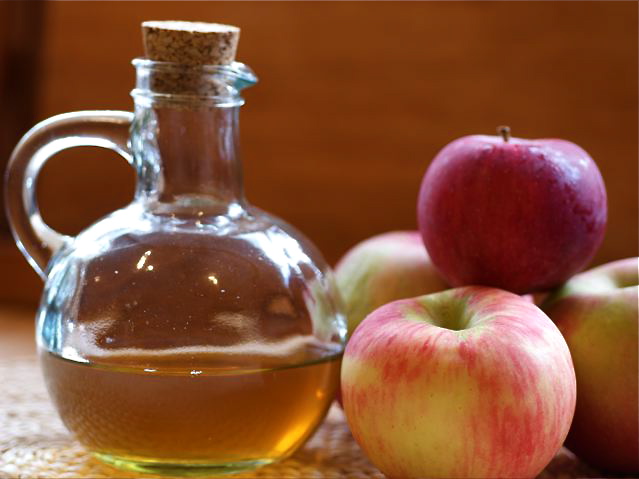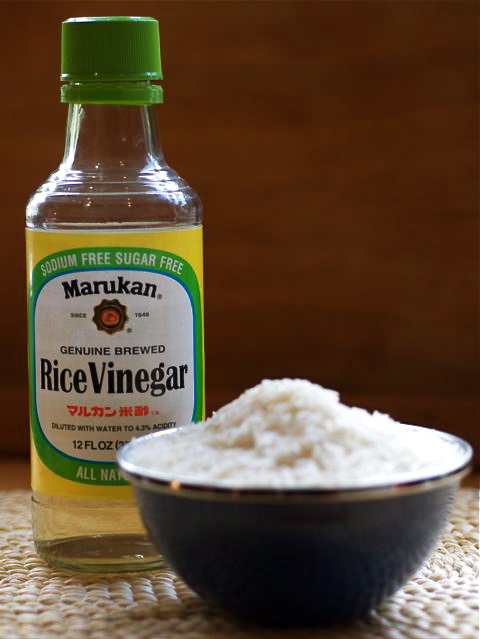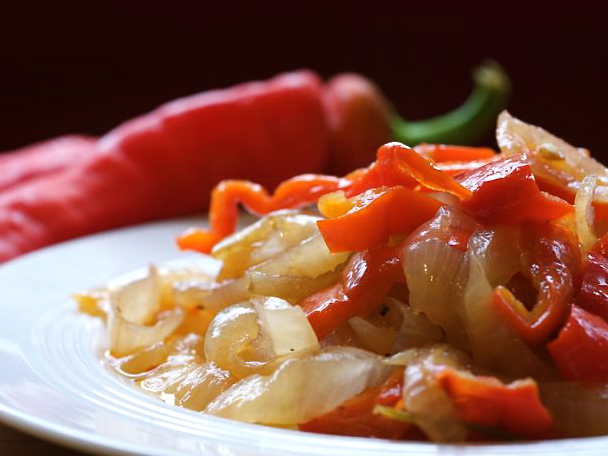
reference-image, l
(article, Kelly Myers)
I’ve been in the dark about vinegar — what exactly it’s made from and how it’s produced — and so, I suspect, have you. Even in this age of enlightened (and sometimes romanticized) scrutiny of our food sources, vinegar sits in a culinary blind spot, waiting for cooks to notice. Sour old vinegar gets taken for granted. I rely on it, though, absolutely. I add a splash of vinegar when I want to shine a light on foods in a way that salt alone cannot. [[block(sidebar). h1.Featured recipe]] Vinegar’s acidic punch plays up all that is sweet, spicy, or earthy. Additionally, vinegar can have the effect of making these flavors taste cleaner and lighter than they otherwise would. Try a beet salad without vinegar (and no cheating with lemon juice), and you’ll see what I mean. Maybe we take vinegar for granted because we no longer take the months required to make our own vinegar. Few of us keep stoneware crocks of the stuff in various stages of development. Although I’m lucky to have restaurant-quality vinegars available to me in my work as a chef, I recently looked into how commercial vinegars are made. After all, I have to shop for groceries, too, in stores featuring shelves of vinegar made by companies I know nothing about. [%image reference-image float=right width=400 caption="Vinegar quality depends, in part, on the source material."] Vinegar quality depends on two things: the vinegar’s source material (what the vinegar is made from) and the length of time, if any, the vinegar is allowed to age and develop flavors. Vinegar can be made from any sugar, making for a broad spectrum of choices. Besides wine vinegar, there is cane vinegar, malt vinegar, cider vinegar, East Asian black vinegar, purple sweet potato vinegar, balsamic vinegar, and vinegars made from white and red rice. Regardless of the source material, you should be able to detect other flavors in vinegar besides tartness. Look for notes of fruit, caramel, wine, sweetness, herbs, or vanilla, for example. Should you choose to conduct a vinegar tasting, you’ll want to ease the condiment’s sting with chunks of neutral white bread for dipping. And please, don’t do a taste test first thing in the morning; your taste buds will suffer. h3. Making vinegar All vinegars are made from a two-part fermentation process. The source material, usually fruit or grains, is initially fermented, creating alcohol. Then bacteria (acetobacter) are added, which in the presence of oxygen converts alcohol to acetic aced. Acetic acid is what gives vinegar its sour flavor. In the traditional French process of making vinegar, known as the Orleans method, wine is fermented with acetobacter in wooden barrels or covered vats with screened air vents. Complete acetification takes months. Modern commercial production of vinegar, on the other hand, speeds up the process by forcing air and cells of acetic-acid bacteria through the fermenting liquid, which is held in stainless-steel tanks. The two most commonly used processes are called “rapid generator process” and “submerged culture fermentation” or “submerged aeration.” Praise for the little-used Orleans method, a slow technique that requires great resources of time and space, comes easily. Truly unique and rounded flavors come from slow acetification in wooden barrels. I love my bottles of Orleans-method vinegars made from red wine and late-harvest Sauvignon Blanc, which can run as high as $11 for a 375-milliliter bottle. Their flavors are so concentrated and complex that my salads need less dressing when I use them to make vinaigrette. Too bad there’s no way to know, from their labels, that these vinegars are made using the Orleans method; I learned of them from a colleague. Later, a retailer told me about the slow Orleans process. But I’ve not yet seen a vinegar labeled “Orleans method.” [%image peperonata float=right width=400 caption="The classic Italian dish peperonata is finished with vinegar."] h3. Tasting vinegar Do you appreciate the layers of aroma and complexity found in a nice glass of wine? Well, some supermarket brands of red-wine vinegar are reportedly made not from wine grapes, but from Concord grapes, the sweet purple grapes that serve as the source material for Manischewitz wine and the jelly in a classic PB & J sandwich. A vinegar with complex flavors of its own will pick up and enhance the flavors of your food. My Gravenstein apple-cider vinegar (made with the Orleans method) has an aroma of fresh, cold apples, like the farmers’ market in October. This summer it was perfect on coleslaw; its fruitiness accented the peppery green cabbage. In the winter, I’ll use cider vinegar for sweet-and-sour braised red cabbage with onions and apples. Artisanal vinegar brands readily advertise their sources and method, particularly if they’re unique or specific — for example, “Jerez district” sherry wine “aged in a succession of white-oak casks.” However, I’ve bought bottles of vinegar that claim to have been aged in oak barrels, and they haven’t tasted as balanced as other lower-priced vinegars. Confusing matters more, most vinegars labeled “artisanal” are not made using the Orleans method. One California vinegar maker, Karen Fahden of Sonoma Vinegar Works, defends her choice of the quick-generator process, noting that her base materials are wines that have already been aged, thus negating the need for additional aging during the second fermentation. Vinegars made on a large scale are even less transparent as to how or from what the vinegars are made. Seek the advice of a trusted retailer, or a friend with a well-stocked pantry. But I’m not turning my back on affordable, quick-method vinegars. For about $7 a bottle, you can find a solid red- or white-wine vinegar to use in vinaigrettes, barbecue sauces, and pickling. I use red-wine and Champagne vinegars from Beaufor. Rice vinegar is also relatively inexpensive; the popular Marukan brand, for example, only costs about $4 a bottle. Besides its uses in East Asian cooking, many like Marukan’s rice vinegars for salad dressings because, like rice, they’re mild and lightly sweet. Some wine vinegars run as high as 7.5 percent acidity, but Marukan is about 4 percent, making overly sour vinaigrette less likely. h3. Using five common vinegars First, a disclaimer: Mine is a kitchen of mostly Western cuisines. That said, here are the vinegars I turn to and why. h4. Red-wine vinegar This is my everyday vinegar. I use it to braise lamb in the Roman style, with chiles, rosemary, and garlic; in tarragon mayonnaise or garlic aïoli; on a marinated cauliflower salad with green olives and mixed herbs; for a salad of bitter greens with garlic mustard vinaigrette and croutons; and on coleslaw. Serve grilled meats with the piquant herb sauces salsa verde (Italian) or chimichurri (Argentine). Both sauces are lively condiments, with the high acid snap of red-wine vinegar. They also brighten roasted or poached chicken and baked fish. h4. White-wine or Champagne vinegar These vinegars are good for pickles, vinaigrettes, and marinated vegetables. I lighten creamy salad dressings by first making a vinaigrette, then whisking in just enough heavy cream, sour cream, or mayonnaise. That way the flavor is brighter and I don’t use so much of the white creamy stuff. [%image marukan float=right width=300 caption="Rice vinegar is made from rice."] The same technique holds true for keeping classic potato salad from getting dull and heavy. Sprinkle the potatoes with white-wine vinegar and salt while they’re still warm. Let them marinate for a bit before you add the mustard and mayonnaise and other ingredients. Champagne vinegar also enhances the flavor of celeriac. Add a few drops to a purée of celeriac (also known as celery root) and potato, and the celery flavor will pop. h4. Sherry vinegar Pair sherry vinegar with walnut oil for a rich salad dressing to take you through the winter. It will be a good companion to salads with pears and cheese, beets, nuts, and with all of the assertive greens we find in cold weather — spinach, frisée, arugula, and escarole. h4. Apple-cider vinegar A natural with braised cabbage, onions, and apples. Apple-cider vinegar is good in any salad with fall fruit. My co-workers like to pickle sliced red onion in apple-cider vinegar with cloves, garlic, tarragon, and cinnamon. h4. Balsamic vinegar Buy this only when you can afford the real thing and treat it like the very special condiment it is. Authentic artisanal balsamic vinegar is a rich elixir made from the juices of the Trebbiano grape, which are cooked down and then aged over a period of years in a succession of barrels made from different kinds of wood, including cherry and oak. Drizzle balsamic vinegar over slices of fried winter squash, roasted poultry, and grilled radicchio wrapped in bacon or pancetta. For dessert, serve balsamic vinegar over ripe strawberries and peaches, or over vanilla-bean ice cream with a cornmeal cookie. I myself am going to search out some coconut vinegar, made from the sap of coconut trees. When you no longer take vinegar for granted, you realize there’s a whole world of it to discover. p(bio). Kelly Myers is a chef and writer in Portland, Oregon. She is also the co-director of Market Chefs, an organization dedicated to inspiring and teaching consumers to cook local foods.

reference-image, l

marukan, l

peperonata, l